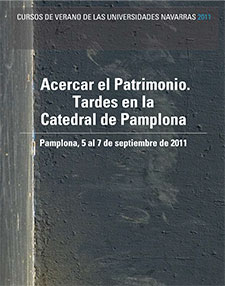BRINGING HERITAGE CLOSER. EVENINGS IN PAMPLONA CATHEDRAL.
September 7, 2011
The Cathedral today and tomorrow: ongoing projects
D. Francisco Javier Aizpún. Episcopal Vicar for Heritage. Archbishopric of Pamplona
I. A UNIQUE CATHEDRAL COMPLEX
The Cathedral complex of Pamplona is the only cathedral complex in Europe that remains complete and alive.
1. Cathedral complexes disappear in Europe mainly for two reasons: the secularisation of the town councils from the 16th century onwards and the restorations of the 19th century according to the criteria of Violet Le Duc.
2. The Pamplona complex has been preserved thanks to the late secularisation of the Pamplona chapter in the 19th century.
II. A DECADENT CATHEDRAL COMPLEX
However, although it has been preserved, it is in a fairly advanced state of deterioration and decadence. Moreover, due to a series of historical circumstances, the cathedral has remained on the margins of city life.
1. The secularisation of the Chapter and the decadence of the Cathedral complex:
a) Causes of the decadence of the complex.
b) The need to adapt the complex to the new functions.
c) The new functions have to be related to the Bishop's Chair , that is to say, with the mission statement of transmitting the faith of the Church and the possibility of creating spaces of meeting with the faith (what Benedict XVI calls the Atrium of the Gentiles).
d) The mission statement of the museum has to be in this area of the Atrium of the Gentiles.
2. The decline of the cathedral church:
a) The externalisation of the parish of San Juan Bautista and the lack of worship.
b) The Cathedral and the Museum: the closure of the façade, the closure of the cathedral.
c) The degradation of the Navarrería.
d) The growth of Pamplona and the marginalisation of the Navarrería.
3. POSSIBLE SOLUTIONS
1. The solution of the Gothic cathedrals: a leap in scale (larger size) to recover centrality in the urban fabric.
2. The Guggenheim or Apple Cube solution: the search for innovative designs or novel and controversial forms.
3. A great cultural project that manages to break down spatial-temporal barriers: liturgy, speech, teaching and research.
a) Renewing worship.
b) The Museum
c) An academic centre
d) A research center.
4. SHORT AND MEDIUM-TERM PROJECTS deadline
1. Small actions in the Romanesque Palace:
a) Cleaning of canon bedrooms and conference room de las Cortes.
b) Refurbishment of the Baroque loggia.
c) Consolidation of the forging of the Teatrillo.
2. La exhibition in 2012: the inauguration will be on 19 March.
3. Visitable excavations in the lower bedroom of the Romanesque Palace, as part of the exhibition.
4. partnership with universities.
5. Plan director for the Cathedral complex.
6. The solution to the entrance of the Museum by the Façade and the small house.
7. Cathedral choir and organ on the façade wall.
8. Building for the file.
PROGRAM
Monday, 5th September
The Cathedral in the History of Navarre: the cathedral, the chapter, the institutions and the bishop.
D. Luis Javier Fortún Pérez de Ciriza. Royal Academy of History
Capitals and keystones of the Cloister of Pamplona Cathedral. That unknown world
Ms. Clara Fernández-Ladreda Aguadé. University of Navarra
Travellers' views of Pamplona Cathedral
Ms Carmen Jusué Simonena. UNED of Pamplona
Tuesday, 6th September
Sumptuary arts in the Cathedral
D. Ignacio Miguéliz Valcarlos. Chair of Navarrese Heritage and Art
Artists in the Cathedral. Esteban de Obray, master of choir stalls.
Ms. María Concepción García Gainza. Chair de Patrimonio y Arte Navarro
A stroll through the canonical dependencies of the cathedral
Mr Javier Martínez de Aguirre. Complutense University of Madrid
Duplicate visits to the cathedral complex in Pamplona
Wednesday, 7th September
Golden scenery: the baroque altarpieces
D. Ricardo Fernández Gracia. Chair of Heritage and Navarrese Art
The cathedral today and tomorrow: projects in progress
D. Francisco Javier Aizpún Bobadilla. Episcopal Vicar for Heritage. Archbishopric of Pamplona
CLOSING: Concert at position Choir Santa María la Real de Voces Graves

